
“Trees require care and tidying up, so they’re not convenient anywhere, but they are necessary everywhere.”
Welcome to the Comment of the Week, where we highlight good comments in order to inspire more of them. You can help us choose our next one by replying with “comment of the week” to any comment you think deserves recognition.
It’s always worth keeping an eye on Scott Kocher, he has a track record of successfully getting the city’s attention on a number of issues. Urban trees, and their importance to cooling the city, have become a focus for him.
We published last week’s post, You have trees to thank for Portland’s cool streets, a year after the deadly “heat dome” killed 72 people in Multnomah County, many in east Portland which has the most anemic tree canopy in the city.
Scott was ready with some code changes in response. We’ve added a couple of images to illustrate his points. Here is what he wrote:
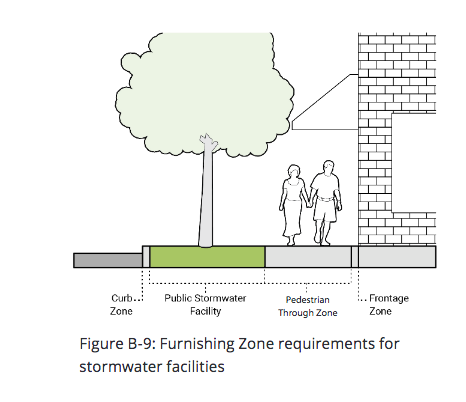
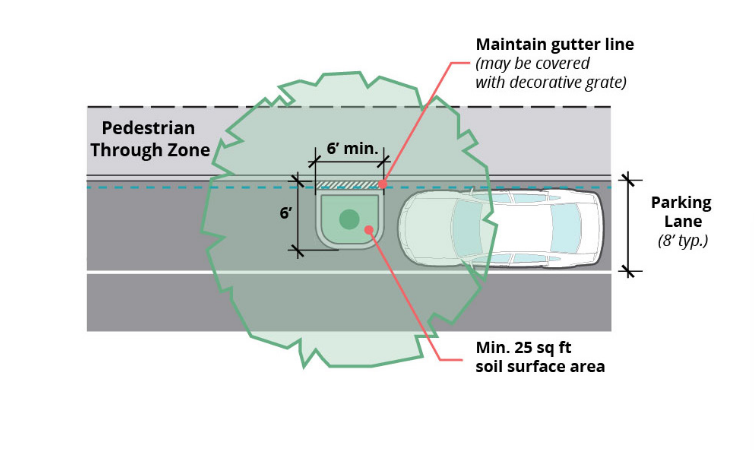

My observations are that new development routinely allows other competing uses (utility poles, underground utility vaults, on-street parking, etc) to supersede the “required” number of street trees planted, resulting in few or even no trees along many frontages that are now being redeveloped. And, current tree code limits the places trees must be considered for planting, and the size of allowable trees. 25′ canopies are now the max for most species allowed in 3′ planting strips.
Replacing a huge old tree with a miniature species results in net loss. I would like to see the tree code amended to require at least consideration of curb zones and medians for street tree plantings, for existing and new development. While future bike lanes, or underground utilities make this impossible some places, there are many other places where large-form trees could be planted in large wells, including East Portland streets that have no curbs.
Trees require care and tidying up, so they’re not convenient anywhere, but they are necessary everywhere.
Thank you Scott! You can read Scott’s comment, and the full comment thread, under the original article.
(Disclosure: Kocher is a Portland-based attorney and safety advocate, and his law firm, Forum Law Group, is a financial supporter of BikePortland.)


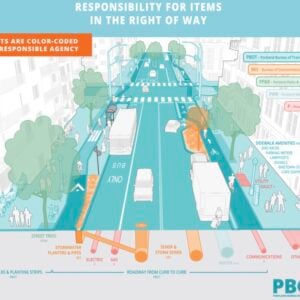
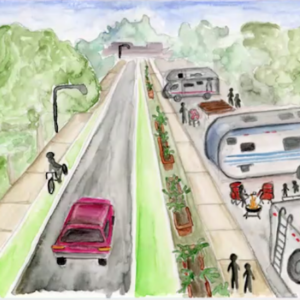
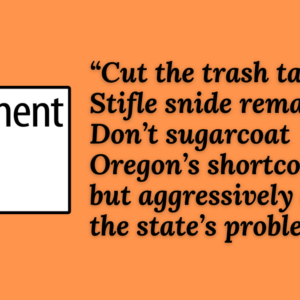
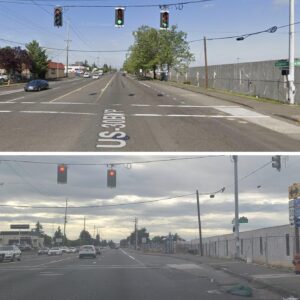
Thanks for reading.
BikePortland has served this community with independent community journalism since 2005. We rely on subscriptions from readers like you to survive. Your financial support is vital in keeping this valuable resource alive and well.
Please subscribe today to strengthen and expand our work.
We have experienced this goofiness firsthand. We lost several huge old trees on our street in the last few years to storms, but we can‘t replace them with anything that will grow over 25′ tall. There are also limits on how far the canopy can extend over the street. Yes this makes things [easier] for PGE (line maintenance esp. during storms) and PBOT (leaf removal) but I would (personally) pay more for those services in return for more trees
I find it pretty rich that the city laments the fact that its policies are working exactly as designed. If we want more tree canopy, we need to incentivize planting more trees and bigger trees. It’s really not much more complicated than that.
I lost a huge elm a few years ago to age and disease. It was growing in my parking strip. After I paid for it’s removal (at no small cost), the city guy visited and reminded me that I was required to replace the tree. Only thing was, he said that my parking strip was an inch or two too narrow. I wasn’t allowed to plant even a modest sized street tree in the place where a towering elm once stood.
I wish I could fulfill my obligation to replace by buying a tree for Portland Parks and Rec to plant in a park where there’s a need.
I wonder how likely it is the city would send someone around to check up on your tree if you get an approval, plant an approved tree, them later replace it with something else. And if they would notice the change in species. Maybe the answer is very likely, I don’t know. But it might be worth a try.
bury our power infrastructure
fewer outages & allow the trees to grow without topping them prematurely
Bury low-density housing and build tall housing towers and forests.
I’m for a classical liberal view that allows diversity and inclusion in housing options. I enjoy my single family dwelling and back yard. I don’t begrudge your choice to live in a tall housing tower.
But you do begrudge it, or you wouldn’t feel so threatened by the mere mention of higher density housing that you take a comment that had nothing to do with you as something to get defensive about.
Threatened? Defensive? No. I’m no snowflake. Sometimes, I just feel that it is important to rebut, offer a contrary view, when I don’t agree with another’s opinion. A civil discourse should be able to handle that.
I am very bummed out about the way the city has decided to cut costs and prioritize parking on the 72nd avenue project. We were supposed to get planter strips that could support trees and would physically protect the bikeway in front of our house, but now we are going to get additional street parking and ugly plastic wands. It is crazy to me that the city is forcing additional street parking on neighbors who don’t even want it.
I love Scott’s code recommendations. Creating tree planting areas in-line with the parking zone has so many befits: Bigger trees, fewer utility conflicts, visually and physically narrows the street (slower/safer), inexpensive (maintains curb/gutter. The only downside is the slight reduction parking. I also like the suggestion to include trees in stormwater treatment facilities, but soil is the biggest challenge here. The City uses a calculator to determine the size of a stormwater planter and allows a rock under-drain beneath the soil to increase capacity. This creates a moisture gap between the groundwater in the soil and stormwater soil that causes the stromater soil to dry out more quickly and more completely than native soils. This is why you see so many dead plants in these planters. Compounding the issue is the BES-mandated soil mix which is basically sand and compost. This blended soil drys out very quickly and the compost promotes very fast top growth (high in Nitrogen). A tree planted in this condition will grow branches quickly during the wet spring, but have difficulty rooting through the open gravel. When summer commes and things dry out quickly, the dtree will have some die-back of branches and roots, but still be top-heavy and poorly anchored in the loose rock. These trees are likely to dies or tip over. BES could get rid of these rock drains, or replace them with topsoil for 6′-8′ under each tree. BES should also revise their blended soil to include more topsoil and less compost to benefit all the plants. A final suggestion is the promotion of climate0adapted plants. So many of the trees planted in Portland are native to humid places that receive summer rain- Maples, Zelkova, Birch, Pear, etc. Our summer droughts cause these trees to send out their aggressive surface/shallow roots to seek moisure which is often found trapped under sidewalks or parking lots. These roots eventually heave and destroy the hard surfaces. Trees adapted to summer/occasional drought are less likely to have that root response; their strategy is to send roots deep, and to reond to drought by conserving energy which makes them far less likely to damage hardscape. These trees can live in narrower planting strips and provide relatively large canopies. Portland should seek out locations where large conifers can be planted. These are not appropriate everywhere, but they are incredinbly good at filtering air, providing shade, intercepting stormwater and providing habitat.
People I know in Washington (the state just north of us) marvel at how my power goes out regularly. Their utilities are buried underground so they don’t lose electricity every time the wind blows. And they are able to have large trees b/c the power company doesn’t cut them down or trim them back so they cling to life and then die.
Let’s face it: Portland is an utter shambles. We all need to vote for the charter revision in November. It’s our only hope of ever improving this place.
That’s a first step, voting for a new Charter, but folks continuing to vote for do nothing social just warrior Wanna-Be’s isn’t going to lead to change either, new charter or not.
There is no evidence that I’ve seen — none — that charter reform will make any improvement to any of these issues. All it will do is create muddled lines of responsibility and overly complex ballots, and cost a lot in the process.
Scott makes good points. So many street trees here are crammed into tiny cutouts in already-narrow sidewalks. They’re set up to live tortured, short life spans. If you actually look at many urban street trees here, you can almost sense their suffering.
Meanwhile, three feet away is a seven-foot wide, block long on-street parking zone. Portland should do for urban trees what it’s doing for restaurants, and convert a portion of parallel spaces to tree planting areas. Taking out just one space per block would create four of the 6′ x6′ spaces shown in the article’s diagram, instead of the current tiny grated sidewalk holes. Taking out 250 parking spaces would add 1,000 street trees in decently-sized planters.
The canopies would extend further over the street paving, sidewalk space wouldn’t be reduced, and trees could be larger and healthier.